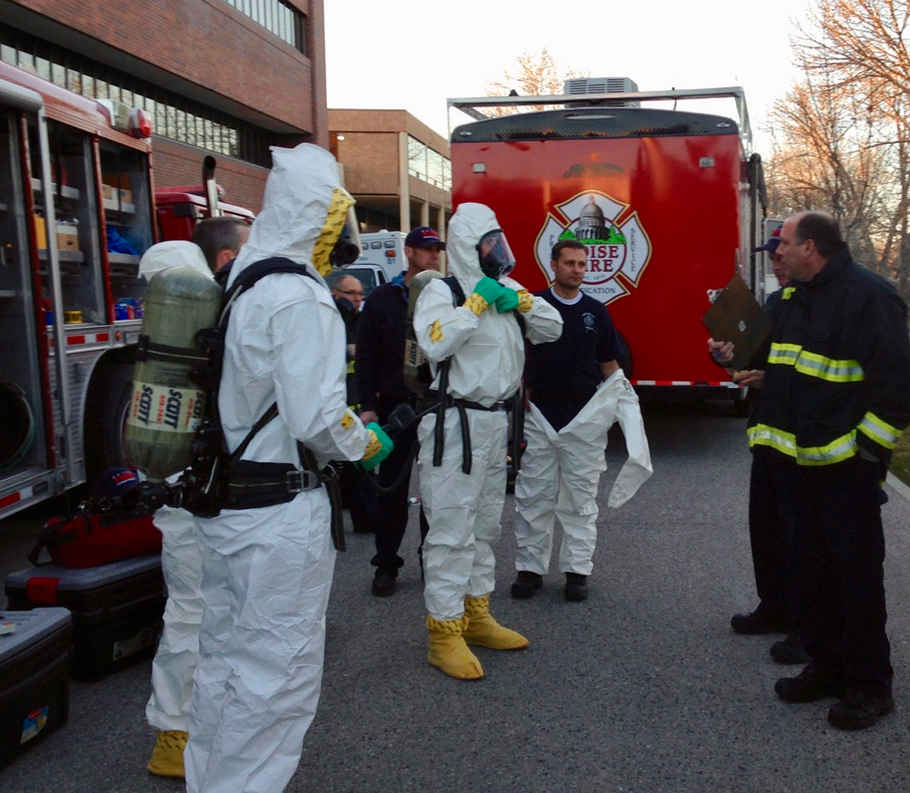Hazardous Materials

A hazardous materials incident is defined as “an uncontrolled release of a hazardous material”.
MAJOR HAZARDOUS MATERIALS INCIDENT
If the release is highly toxic, involves a substantial amount of material, or cannot be safely contained without endangering yourself or other personnel, follow these steps:
- If the release is inside a fume hood of a lab, lower the sash.
- Alert others in the area to the presence of the release or spill.
- Turn off any gas burners if you can do so without putting yourself in harm’s way.
- Retrieve a material safety data sheet (MSDS) on the hazardous material if safe to do so.
- Evacuate the area, closing doors as you leave.
If there is a threat to the occupants of the building:
- If an explosion risk is present, avoid turning electrical equipment on or off and activate a fire alarm from a different floor or building to prevent generating a spark.
- Pull the fire alarm to alert others in the building to evacuate.
- Call 9-1-1 from a safe location.
- From a safe location, call Department of Public Safety at (208) 426-6911 and then Environmental Health, Safety & Sustainability at (208) 863-8024 (24 hr cell).
- Arrange for those most familiar about the details of the incident and general knowledge of the material released to meet with those providing assistance as needed. Bring a material safety data sheet (MSDS) if possible.
- See the HAZARDOUS MATERIALS EXPOSURE section for treatment of those exposed to the hazardous material. Isolate contaminated persons and do not allow them to leave or to spread the contamination. Avoid hazardous material contamination or exposure to yourself.
- If safe to do so, post “HAZ MAT INCIDENT- DO NOT ENTER” signs on the entrances to the area
If you are exposed to a hazardous material:
- Ensure you are in a safe location.
- If injury is serious or life threatening, call 9-1-1.
- Use eyewash or safety showers as needed to wash off hazardous materials. Flush the affected area with copious amounts of water for at least 15 minutes.
- Anyone who has had a hazardous materials exposure, including a potential exposure, must follow the steps as outlined in the WORK-RELATED INJURY OR ILLNESS section to obtain medical treatment if needed and complete appropriate university documents, etc.
MINOR HAZARDOUS MATERIALS INCIDENT
If the release involves a small amount of material and can be contained without endangering yourself or other personnel, follow these steps:
- If the release is inside a fume hood of a lab, lower the sash.
- Alert others in the area to the presence of the release or spill.
- If cleaning the release or spill is within your training and comfort level, you may follow your group’s procedure to clean it up. Otherwise, evacuate the area and treat as a MAJOR HAZARDOUS MATERIALS INCIDENT above.
- Retrieve a material safety data sheet (MSDS) on the hazardous material if safe to do so.
- Keeping yourself between the hazardous material and an exit to avoid being trapped.
- Call your supervisor, then Environmental Health, Safety & Sustainability at (208) 863-8024 (24 hr cell).